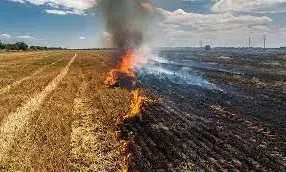A Burning Issue Ignored?
Harmful smoke generated from stubble burning has become a plague in all of north India

The components of the Union Budget 2023-24 have been analysed in great detail. Allocations to agriculture have not been dazzling this time. The ‘Doubling Farmers Income’ program which was to achieve its spectacular goal by 2022 has failed decisively, and there was no evidence of further support to this overly ambitious project.
The expectation that big grants would be seen in the agriculture sector to make farmers happy before the 2024 general election was also belied. But the possibility remains open of some blockbuster bonanza for farmers being announced closer to the elections.
What I would have liked to see in the agriculture budget though is some allocation for farm machinery and technology to control or do away with stubble burning. Stubble refers to the lower portion of the stalk and root of the rice, wheat or any other crop that is left in the field after the top portion of the crop, which carries the food grain, has been harvested. The stubble is burnt to remove it from the field to prepare the field for the next crop.
Finding a solution to remove crop residues by alternative means is eminently doable and not supporting it in the budget has been a missed opportunity. The impact of stubble burning on the environment, especially the air quality, is colossal for the 10- 15 days that stubble is burnt post the kharif crop harvest in November- December.
The harmful smoke generated from stubble burning has become a plague not just in Delhi where it receives the most attention but in all of north India. Doctors in hospitals across regions of north India confirm that poor quality air during winter is causing great damage to the health of people, especially children. Respiratory diseases are on the rise and the elderly are highly vulnerable to the cocktail of pollutants in the smoggy, hazy air.
On a recent visit to Goa, I was shocked to find that the practice of burning crop residues in the field has reached there as well. This is likely to spread to other agricultural areas. In the absence of an alternate means of freeing the fields of the previous crop and making them ready for the next crop, clearing by setting fire to the stubble is the cheapest and easiest way available to the farmer.
It is surprising that no serious effort has been made to address this problem since simple technological interventions exist already. Much of the wheat and paddy harvest in Punjab, Haryana and Western Uttar Pradesh is done by the Harvester Combine, a machine that cuts the top portion of the plant carrying the grain bearing ears.
This machine leaves about 12 inches of the straw in the field . This stubble has to be removed and the economics of farming is so precarious that the farmers cannot spend extra money on labour to remove the stubble manually before planting the next crop. Farmers thus have no choice but to set fire to the stubble to clear their fields.
The easiest most straightforward solution is to modify the harvester machines to cut the stem/straw close to the ground, leaving no stubble in the field. Harvester Combines abroad have this simple feature with an addition. The same machine cuts all the straw, threshes and separates the grain and rolls up the straw into bundles.
Those who have travelled abroad will have seen such bales of straw lying in the fields after the machines have removed the grain. Incorporating this feature is not rocket science and can be easily done in Indian Harvester Combines.
After years of worsening air pollution every winter, I would have liked to see some response in the budget. An incentive or subsidy can be provided to manufacturers of Harvester Combines so that they can modify their machines to cut stubble at ground level so no stubble is left to burn.
This one-time subsidy would not be a large one and can be recovered over one or two harvests from the machine manufacturers. There could be many ways of doing this so that farmers are not made to bear the cost.
There is another aspect to this. When farmers have to burn the stubble, they lose in many ways. They are losing that much straw that can be used as fodder for livestock.
Surplus biomass left post harvest can be used to make hard and soft boards for use in construction and furnishing interiors, packing material and a valuable product called biochar to improve soil health. But more on that next time.
Dr Suman Sahai is a scientist and chairperson of the research and advocacy group Gene Campaign.


